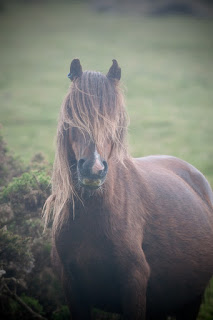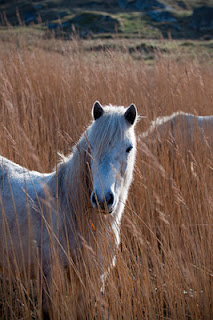Welsh mare and foal
Here is some more about one of Britain's wildest pony breeds (and one of the most endangered) living on the Carneddau Hills in Wales.
They are actually pretty wild, on alert all the time and are very suspisious of anything unusual happening around them.
While I was there I was quietly watching a group of ponies having a nap in the sun. They were all quite relaxed, but some were still on the lookout.
Welsh ponies dozing in the sun
Quite relaxed
All of a sudden, out of no where came a scary plastic bag flying about on the wind. The ponies were all instantly awake and running from the 'predator'.
Fleeing the plastic bag
They ran for a bit then stopped to see if they were being chased by the scary bag, and when they realised that the bag was just a bag, they soon settled down again and began to graze.
An article from Wales online written in June 2011 explains how the wildness of the ponies could be contributing to the decline of them, and why the farmers who owned the ponies decided to ask Barry Thomas a local horse whisperer to help - here is a small piece from the article:
" “People assume they are too wild to tame,” said Mr Thomas, of Crymych, Pembrokeshire.
“Therefore they are not marketable, they cannot be sold, they cannot fetch a price, so the farmers cannot afford to keep breeding them.
“There are only around 200 of the ponies left on the hills of Snowdonia, so anything that can be done to save them must be done.”
After an end-of-season sale last year in which 45 of the Carneddau ponies were sold for just £430, Mr Thomas was asked to see if he could do what nobody has ever done before: tame and train a Carneddau pony.
The Carneddau Pony Society hoped the training would help increase the animals’ market value, which in turn would give the Snowdonia farmers the incentive to breed them."
A similar thing had been done before by Monty Roberts, the American 'horse whisperer' when he had tamed and trained a wild Mustang. Barry Thomas is actually one of Monty's students and was glad to accept the challenge.
He captured 2 of the wild ponies and brought them back to his farm. He did succeed in taming and training them, and there was a programme filmed about it but unfortunately I can't find it to watch. Whether it has helped with the popularity of the Carneddau wild ponies, or whether people will want to own them is to be seen, but the Carneddau ponies more domesticated cousin - the Welsh section A pony, is very popular. In the next blog I will look at the breed characteristics and see why they are such great little ponies.
Read the whole article here
Beautiful chestnut mare





































